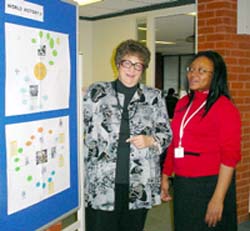A Technology Artist in Residence
Judith Cramer, an Educational Technology Specialist at TC, spent 10 days in January as the first Technology Artist-in-Residence at the American Community School (ACS) outside London. Cramer was invited by TC student Patricia Davies, who is High School Computer Head of Department at ACS.
The two educators met in the summer of 2001, when Davies enrolled in a course Cramer taught for the Intensive M.A. program in Communication, Computing and Technology in Education sponsored by the Center for Technology and School Change. They found they had a lot in common. Both had experience as technology specialists at international schools, Davies in her native Sierra Leone, Cramer in New York City. Those experiences convinced them that technology can level the playing field for children from diverse cultures and with diverse learning styles.
Returning to Freetown, Davies made use of the project-based approach to technology integration demonstrated in Cramer's summer seminar, but when she transferred to ACS, a school of 1,000 students, she found she had little time to work on integrated projects.
"Even in resource-rich schools like ACS or the United Nations School (UNIS) where I taught," said Cramer, "infusing technology in curriculum is difficult. Like every other teacher, the computer teacher has mandated content, especially where there is both an IB and an AP curriculum, as there is at ACS and UNIS."
After hearing last summer that Cramer might be in London over winter break, Davies put the Artist-in Residence (AIR) proposal in motion. "I thought if anyone could jump start our technology integration, Judith could," she says. ACS invited Cramer to work with high school students and teachers; later teachers from the other divisions asked for after school workshops.
"Lucky for me, Patricia got some high school teachers to volunteer," says Cramer with a laugh, adding that they taught subjects she was comfortable with: English, second languages, history.
"I was trained originally as an English teacher, and last fall I did a presentation at NCTE about writing and technology, so I had given quite a bit of thought to that subject in advance of my AIR assignment" she says. "I had more preparation to collaborate with the languages and history teachers, and here my work at TC made a big difference."
Cramer emphasized information literacy and visual literacy in the projects she devised for students at ACS. Everyone did Internet research, focused especially on primary sources, and then used mapping and multimedia applications to represent their knowledge in works that could be shared with the school community.
According to Cramer, the World History projects were the most sophisticated-and not just because those classes met more often than the others, she insists.
"I have to thank Margaret Crocco and Steve Thornton for making me think like a social studies teacher," Cramer says. "Social studies was always last on my list, from the time I was a kid in school to the time I became a teacher myself. Now, thanks to Crocco and Thornton, I'm a social studies maniac, if not yet a maven."
Published Monday, Sep. 13, 2004
